The 2016 World Tour begins with the Tour Down Under in Adelaide. This is now a familiar race with habitual finish lines and known climbs but who wins is anyone’s guess given the starting slot on the calendar.
Here’s a preview of the race with stage profiles, the contenders and pretenders for stages and the GC plus TV listings and finish times.
Things begin with a 51km criterium on Sunday, the “People’s Choice Classic” it’s not part of the stage race but still a UCI race and a chance to see shiny bikes and sprint trains in action.
Stage 1: Prospect > Lyndoch, 130.8km – Tuesday
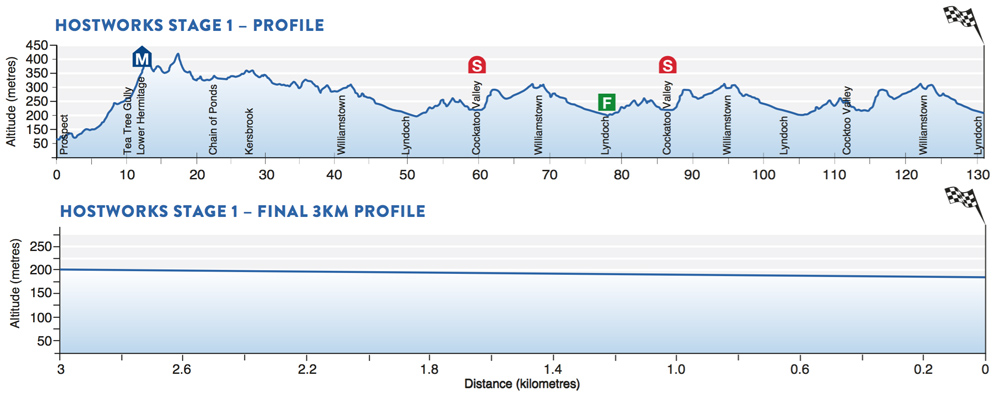
An uphill start with a King of the Mountains climb to incite a breakaway to go clear before the race heads to Lyndoch for several finishing laps. It should be a day for the sprinters and if they miss this chance they could be waiting until Sunday.
Stage 2: Unley > Stirling, 132km – Wednesday
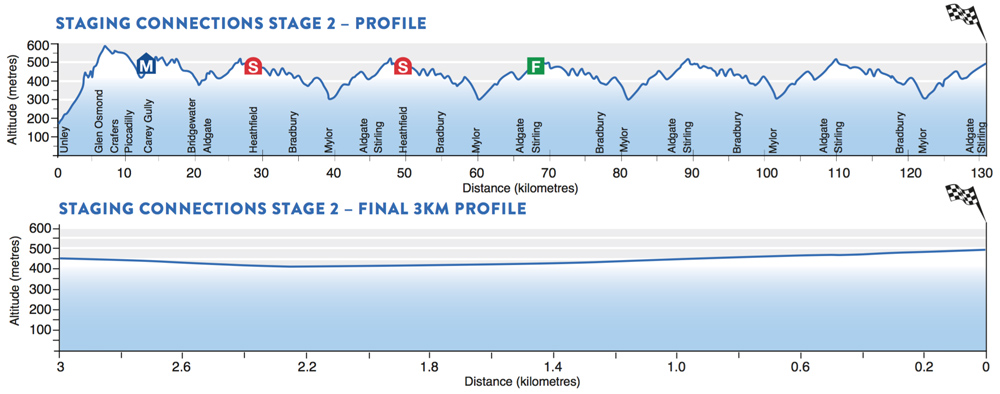
The race leaves the Adelaide suburbs to lap around Stirling. The finish is familiar and knowledge counts here, it’s an uphill run to the line with an awkward approach that rises and falls. Timing matters here, go too early and you can be swamped and dropped. Punchy sprinter Juan-José Lobato won here the last time, before that it was the fast-finishing climber Diego Ulissi. It’s a vital finish for those hoping to win the race overall too as the time bonuses help while anyone sat on the wrong wheel could see a gap open up in front of them and the time losses quickly add up.
Stage 3: Glenelg > Campbelltown, 139km – Thursday
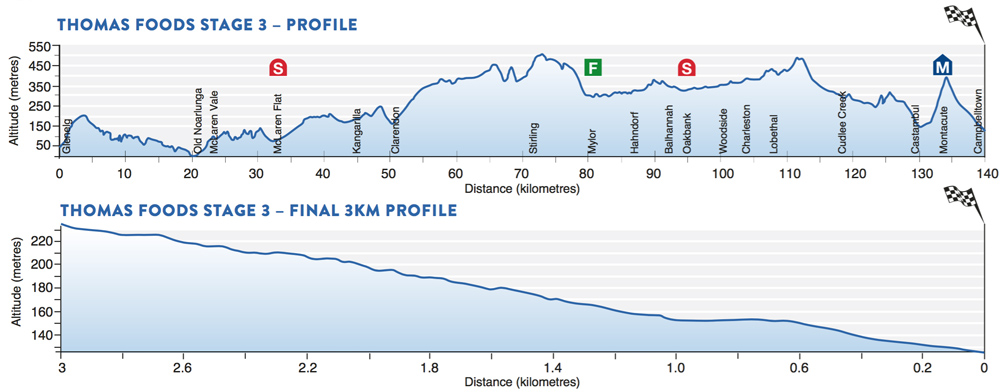
All the sprinters can hope for here is some racing in the legs and a sun tan. The Corkscrew Road climb at the end of the stage is crucial. Coming after Kangaroo Creek – what else? – this road doesn’t take its name from the local wineries, instead it’s got several hairpin bends, a rarity for South Australia and an obvious draw for local cyclists. The climb is 3.7km long and the gradient hits 10% before a fast descent into down and a flat finish.
Stage 4: Norwood > Victor Harbor, 138km – Friday
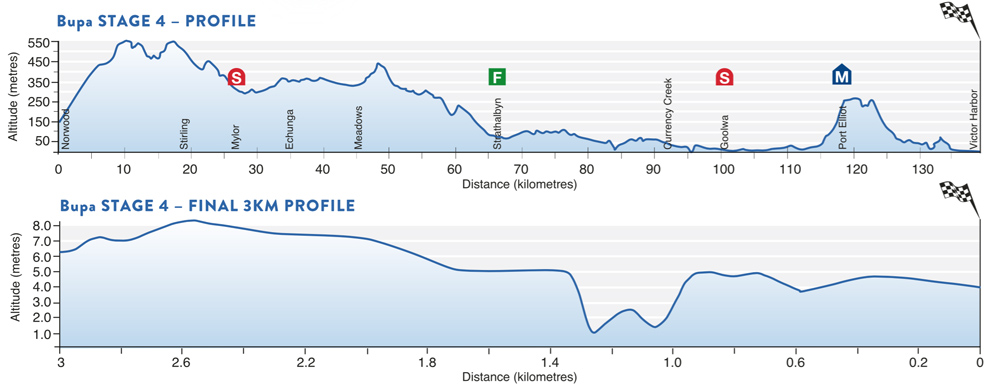
Another regular location, Victor Harbor has often rewarded sprinters. A couple of years ago the race split in the seaside crosswinds. This time sees a more hilly approach with the late climb of the Crows Nest Road above Port Elliot and if the wind gets up it’ll be very damaging for some GC contenders. Crows Nest is 4km at 6% but that’s with a short drop early on the climb included meaning the next 3km are solid climbing with some 10% or more sections. Anyone gapped will struggle to get back on especially if the wind is up and there’s only 20km to go. Blow here or miss the move and you could lose a minute or more, fatal for a race that’s usually decided by seconds.
Stage 5: McLaren Vale > Willunga, 151.5km, Saturday
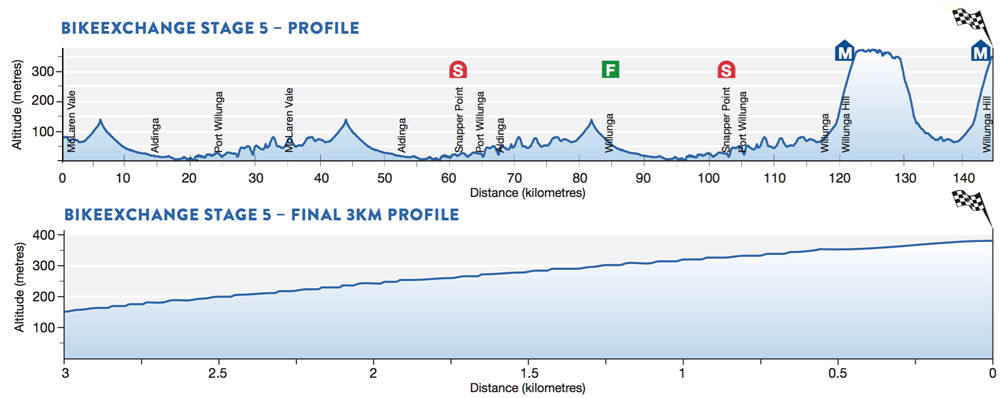
The crucial stage of the race with Old Willunga Hill. The race tours the vineyards and the coast at Aldinga, a circuit that’s repeated again and again. After 120km the circuits end and the race turns to the hills. Old Willunga Hill is the key moment with 3km at an average if 7.5%, a steady gradient and a wide road most of the way. As ever vineyards conjure up sybaritic images of wine-tasting but the racing cyclist knows otherwise, the low vegetation means exposed terrain where a small breeze can be enough to split things up.
Normally this will determine the overall classification and the main contenders will set the pace on the first climb before giving everything on the final climb. It’s a tactical finish, being on the right wheel matters as the speed is so high, the idea is to ride the slipstream of your rival and then strike out as late as possible but before everyone else. Simon Gerrans has pounced several times on here and its one for the puncheurs.
Stage 6: Adelaide, 90km, Sunday

The traditional curtain-closer criterium with 20 laps of the 4.5km circuit with two intermediate sprints along the way. There’s the last chance for a sprinter and because the race can be so close the intermediate sprints and finish line can still decide the overall result, if not the winner then the top-10.
Time Bonuses: 10-6-4 seconds on the finish line every day and 3-2-1 at intermediate sprints

The Contenders
We’ve got very little to go on, even the Australian road race championships was a sleeper race with Jack Bobridge’s excellent raid neutralising all the others. But here goes…
Simon Gerrans is the prime pick. If you had to plump for a prototype winner Gerrans has it all. He can sprint fast to take time bonuses – that’s him pipping Greipel above – and he can cope well with punchy climbs, he’s excellent at sniping wins which matters in a race with set-piece moments. Plus he comes with a strong, motivated team and he’s a local, or at least an Australian. He’s won the race before too. Team mate Daryl Impey is a good back-up plan too.

Rohan Dennis won last year in part thanks to his surge in Paracombe when others were watching Cadel Evans, then Dennis marked Richie Porte on Willunga. Now Dennis will be the marked man and find it harder to slip away but he’s got the raw power and strong team. He’s in form having just won the Australian time trial title. BMC Racing team mate Richie Porte is the pedigree pick, he’s got an increasingly long list of stage race wins to his name and can race aggressively to take time bonuses. Dennis has been talking up his chances to win again but is this to create an opportunity for Porte? Of the two I prefer Porte as the lighter, more explosive rider for the climbs.
Diego Ulissi has done well here before and has good skills to position himself right for Stirling, the Corkscrew, Crows Nest and Willunga. Lampre-Merida team mate Louis Meintjes is an outsider for his climbing skills too but an infrequent winner. By contrast new signing Marko Kump is a prolific winner, at least he was last year as a big fish in small pond Euro races, his speciality is uphill finishes so worth watching even if the form is a mystery. Climber Tsgabu Grmay was 11th last year too.
Who to pick at Team Sky? Normally Geraint Thomas would be best suited and he’s come close to winning the race before but shifting goals and a busier winter means he’s spent less time training in Australia than usual in the past few years. Instead Sergio Henao could be one to watch as he’s a punchy climber who’s come from the Colombian summer. On paper Peter Kennaugh is perfect for a course like this but an unknown quantity form-wise.
Rein Taaramäe is often good for an early season win and if he doesn’t seem to like the heat, the forecast says it’ll only be 25-30°C next week instead of 40°C. He’s part of a Katusha team that includes Tiago Machado who’s cracked the top-10 before, just, in 2013 while Igor Silin is a tough climber too.
Astana always come with a strong team and L-L Sanchez has often done well in this race and forms a useful tandem with the mercurial Lieuwe Westra. Lars Boom will be interesting to watch as he’s good in explosive finishes and has been doing some cyclo-cross racing so could come sharper than usual although he’s way to bulky to feature up the Corkscrew climb.
Cameron Meyer‘s switched to Dimension Data and the one time track prodigy still has the talent to surprise and looked smooth on Willunga last year. A win seems unlikely but he could pace himself into the top-10. Nathan Haas can cope with short climbs and finishes fast, it’s hard to see him winning overall but the stage to Stirling suits if he can control himself, too goes too early too often; time it right and a spell in the ochre jersey awaits.
Another rider trying to recapture past promise is Moreno Moser and there are signs of improvement, whether the gradual pick-up last year or his speedy Strava times in South Australia right now. Cannondale also bring neo-pro Paddy Bevin who can sprint and climb while Simon Clarke is a punchy rider who can help too. Michael Woods is a good climber but the hills of South Australia could be too short for him.
Ag2r La Mondiale bring human dynamo Alexis Gougeard, you’ll remember he won a stage of the Vuelta after burning everyone off his wheel. Domenico Pozzovivo is another top-10 candidate and this year’s route has more climbing than ever but it’s hard to see him getting the better of people named above while Cyril Gautier and Christophe Riblon offer more options.
Among other outsiders there’s Jarlinson Pantano of IAM Cycling, he’s just won a local non-UCI race in Colombia so the form is coming and he’s a versatile rider with a decent finish in a small group; but he rarely wins while team mate David Tanner is a tough climber worth watching. Lotto-Jumbo’s Enrico Battaglin is a classy hire who could thrive if the cultural shift of joining a Dutch team doesn’t overwhelm him; if not team mate George Bennett might be a safer pick. Tour de France stage winner Simon Geschke took his win in the Alps but is more suited to short punchy climbs. Movistar’s Ruben Fernandez made the top-10 last year and could feature again while Jesus Herrada is a versatile rider for hilly courses. Tinkoff’s Michael Valgren is a classy rider but is he aiming for something bigger later this year? Trek-Segafredo’s Julian Arredondo almost vanished from the results in 2015 after a promising 2014 season so we’ll see if he’s wintered well in warm Colombia while team mate Jack Bobridge is in great shape but can he sprint for the wins and outclimb the others? Hard on any given day and now he’ll be a marked man with the green and gold Aussie champ’s kit. Finally the sleeper candidate is Rafael Valls, he emerged in last year’s Tour of Oman to take the summit finish stage ahead of Tejay van Garderen and now with Lotto-Soudal he could feature on the climbs but this race looks too punchy for him.
| Simon Gerrans | |
| Richie Porte, Rohan Dennis | |
| Geraint Thomas, Diego Ulissi | |
| Cameron Meyer, Sergio Henao, L-L Sanchez, Daryl Impey | |
| Moser, Kennaugh, Taaramäe, Valls, Pantano, Kump, Haas |

The Sprinters
A quick scan of the sprinters as they’re likely to feature here too. Caleb Ewan is the local pick and the form pick and perhaps his only concern is sharing resources on Orica-Greenedge with Simon Gerrans who may also want to take time bonuses here and there. Juan-José Lobato was a stage winner last year and returns for more with Movistar. Dimension Data have a sprint train in search of a sprinter, will they put Nathan Haas, Mark Renshaw or Tyler Farrar on the pointy end? The same with Giant-Shimano who will probably count on honorary Australian Koen de Kort. Ditto Lotto-Soudal who might use Pim Ligthart.
IAM Cycling’s Matteo Pelucchi pops up to win World Tour races now and then and has the power and the kamikaze flair to do this; he’s got Leigh Howard who could win too. Team Sky have Ben Swift who’ll have to freestyle things but is used to this thanks to a track pedigree; the same for former British team mate Adam Blythe now with Tinkoff. Trek-Segafredo have Giro points jersey winner Giacomo Nizzolo and Kiel Reijnen for back-up. Wouter Wippert‘s stage win last year helped him sign with Cannondale, now he’s the house sprinter expected to deliver. Katusha’s Alexey Tsatevich can mix things in the sprints some times. Steele von Hoff has won stages before and returns with the composite UniSA team while Brenton Jones is local team Drapac’s house sprinter.
| Caleb Ewan | |
| J-J Lobato, Matteo Pelucchi, Wouter Wippert, Giacomo Nizzolo | |
| Howard, Blythe, de Kort, von Hoff, Kump |
Forecast finish times
Stage 1 – Tuesday: 2.34pm ETA / 5.05am Euro time / 11.05pm EST in US (Monday)
Stage 2 – Wednesday: 2.33pm ETA / 5.04am Euro time / 11.04pm EST in US (Tuesday)
Stage 3 – Thursday: 2.44pm ETA / 5.15am Euro time / 11.15pm EST in US (Wednesday)
Stage 4 – Friday: 3.06pm ETA / 5.35am Euro time / 11.35pm EST in US (Thursday)
Stage 5 – Saturday: 3.02pm ETA / 5.32am Euro time / 11.32pm EST in US (Friday)
Stage 6 – Sunday: 3.30pm ETA / 5.30am Euro time / 11.30pm EST in US (Saturday)
ETA is local time in Adelaide and these are estimates supplied by the race and note the variability in case you’re getting up early or staying up late. If you think it’s a pain, remember Australians and others get this all year with the classics and grand tours.
What to watch? Rather than limiting yourself to particular stages, aim to watch a little of each. Unlike a long classic or grand tour stage all the action and tactics come very late in the race, you’ll rarely miss much if you tune into the last 10 minutes each day, Stage 4 is the exception with the Crow’s Nest climb further from the finish.
Where to watch? It’s on Australia’s Channel 9 and Gem and there’s a livestream page to watch on the web. British viewers can see it on Sky, French viewers on BeIn, Universal HD and NBC Sports in the US and more countries see the race website.
There is also the Tour Tracker app in some countries. Otherwise this marks a return to the furtive practice of watching via a pirate stream and cyclingfans and steephill.tv are the default choices.


Pretty pumped to be heading to Adelaide as we speak to see the TdU. Should be great weather, great riding etc. Pumped.
Thanks Inrng,
I miss the cultural overview you sometimes include at the end of your overviews!
What is the predominant grape varietal grown in this region? Shiraz?
Perhaps one of our Aussie winos might chime in?
Spot on Othersteve. Over 50 per cent of the vineyard area in the McLaren Vale region is Shiraz. Cabernet Sauvignon (17 per cent) and Chardonnay (7 per cent) are the other major varieties. The region has a true Mediterranean climate with some maritime influence, great views (hills and ocean) and diverse soil types. There are a wide range of restaurants and cellar doors to visit. If I have interstate or overseas visitors looking to experience South Australia’s wine region, McLAren Vale is my first choice. What a great place to cycle and, indeed, to have the marquee stage of Australia’s premier pro cycling event.
One of my favorite races. I say it a lot and I’ll say it again: The stage format here is a good template for future races. It’s centralized for racers, staff, and fans; circuits for easy viewing and start/finish areas close enough to transition for fans.
If Velon/Cooksons plans can be previewed, this is probably the type of thing they have in mind.
It works well because of our terrain and the sprawl of Adelaide. It’s also necessary to do laps because of how few difficulties we are able to find around here.
How do you know what Velon/Cookson are planning? I’ve never heard either of them say anything like this.
I’ve thought about that in relation to Dublin – we’ve had no top-level racing in Ireland since the Nissan Classic/Tour of Ireland folded in 1992, (and a short-lived, ill-fated comeback from 2007-2009).
In Dublin we have plenty of cobbles all around the city centre, from gentle Flanders-style to almost Arenberg level down some forgotten laneways. There are also lots of short, sharp classics style climbs like Knockmaroon Hill, Stepaside Lane, the hill of Howth, Killiney Hill (taking you past Enya’s castle), Rugged Lane, Somerton Lane etc. If you want bigger gaps, the Dublin and Wicklow mountains are immediately to the south, with plenty of cat 2 and 3 climbs like the Sally Gap and Wicklow Gap and a 660m climb to summit finish at Kippure, or my favourite the smaller but steeper mini-Planche-Des-Belles-Filles of Three Rock https://www.strava.com/segments/648242 There are plenty nice wide finishing straights for sprinters too, like Phoenix Park which was used in the infamous 1998 Tour.
That’s all within 30km of O’Connell St. A week long stage race could stay in the city centre and have large crowds and every race type bar HC climbs.
I forgot one thing too – a high chance of vicious crosswinds, especially along the coast http://www.energyco-ops.ie/wp-content/uploads/2012/03/3tier_5km_global_wind_speed.jpg
I have no problem with TdU’s format as it’s in January for Pietro’s sake, though to me the WT designation is a stretch. But I’m not so sure about creating more races that revolve around one central lodging location. Something called a “TOUR” oughta go somewhere rather than loop around and round, coming back to the same place each night.
Your opinion is the diametric opposite of all the riders who love staying in the same hotel every night and enjoying minimal transfer time. The last Vuelta was a proper tour of Spain, but the route had many detractors.
I do agree though that the event would make more sense in February as a warm up for PN and TA as well as the classics, but then it wouldn’t line up with the Australian summer holidays so would probably see a dip in spectator numbers.
Staying in one place is no doubt preferable for the riders, but personally I’m not a fan of circuits – it’s more interesting to watch and tactically so if the riders haven’t already ridden the course half an hour ago.
It’s also better for the casual spectator who gets to see the race come by their home, rather than having to travel to the race. And it shows off the country more.
For a country the size of Australia, the current route is probably the only feasible way to run the race. But that doesn’t make it a good idea for racing generally.
Maclaren vale Shiraz are a solid bet. Barossa is also famous for their Shiraz but have much more variety.
Sparkling Shiraz is also a local speciality. It takes a bit of getting your head around, but a good one is fantastic. A bad one is sweet lolly water.
The race goes past the end of my road on two different days this time, and one of the days is the public ride on Friday down to victor harbor.
The early sections of the corkscrew are more like 16% and higher depending on which line you take through the switchbacks, but it’s short and sharp and the descent down to the finish is fast and sharp. First group over the top should stay away if they don’t start bickering
Great preview thanks. It’s worth adding that, if you like combining riding your bike with catching up with seeing the pros race, this is a great holiday option – it’s very relaxed and you can often ride home with the pros after the race (a number of whom will welcome your directions back to the city although their tendency to blow through the red lights can get the locals off-side!) and you can set up routes each day to see the race in various places while you enjoy a terrific day on the bike yourself. Adelaide has a lovely atmosphere for the week.
On the wine front, the Clare Valley and Eden Valley also produce fantastic Riesling – in my view, some of the best in the world – which is capable of ageing for a remarkably long time if cellared carefully.
I’m particularly looking forward to see if Paddy Bevin can match it in this company. Lots of locals think stage 4 could be more decisive than initially thought if the wind blows….
Stage 4 looks interesting, especially as the climb is a bit further from the finish so having a team or two to push on over the top could help a lot.
We’ve been to this race a couple of times before. The weather is always dry this time of year and while the forecast may be 40 degrees, the hottest part of the day is ~4-6pm. So after the race finishes get to the beach in the evening for beautiful sunsets over the water.
We’ve based ourselves at Aldinga Beach – short stroll to the beach and the stage 5 beach loop, then heading over to Willunga Hill.
The stage finishing on Stirling is relaxed and as fun as any. A town in the hills means cooler temperatures and there are great kids facilities too.
The final stage in town is busy but also fun.
Overall it’s a great race to go to whether adults or with kids. It’s probably the only time if the year Adelaide is actually interesting.
Hey! Don’t forget the Clipsal 500 and/or Fringe in March, as well as Test Match cricket and the fantastic NYE T20 game. I still miss the GP and the Rugby Sevens though.
Honestly, as a resident, it isn’t particularly tourist-y, we have great experiences and things to do, and a wonder around Adelaide CBD streets is great but the events really still aren’t here 🙁
You live in Bendigo mate. Hardly the cultural epicentre of the world.
So true!
Aside from a loss making art gallery and an expensive new performing arts theatre.
And don’t forget a regular stage finish in the 2.1 Herald Sun Tour, and an International Madison! !!
Stage 3 is tough. Mclaren flat to stirling is close to 1000m of climbing on dead roads before a quick decent into mylor. Another uphill drag through to lobethal and into the gorge for the run into the corkscrew where positioning is critical. I think this will be the stage to watch. As far as wine choices try a Grenache from mclaren vale. Fantastic drinking
Does anyone know how long the sponsor contract with Santos goes for, and what sort of money Santos brings in? The company is in pretty bad shape since its share took a serious tumble over the last year. They are cutting costs left right and centre. Oil remains low and the LNG market does not look rosy over the next few years (where they are heavily exposed). I’m sure this is the sort of exposure they are looking for, but I have no idea how much they are putting on the table. And when they could call it quits.
No idea about answers to any of your specific questions, but the major backer to this event is South Australia itself. I’m sure naming rights are worth a fair bit of cash from Santos, but Tourism SA and Adelaide council make it happen, and will continue to do so in at least the mid-term, if not long-term.
Just adding, look at the “Major Partners”:
Hilton for accommodation.
Singapore Air for flights.
Subaru for team cars.
Adelaide Council for road closures, police support.
The Advertiser for positive and full media coverage.
yeah, there is a broad base, which is very healthy. As this is a very well attended race (spectators) I can only envisage it will continue for a long time.
Caleb Ewan’s exclusion from your ‘riders to watch in 2016’ list is starting to look more and more concerning inrng ?
Ha, a bit obvious. He’s good but can he go it on a wet Wednesday in Wevelgem?
Serious question, what do you think his cobbled skills would be like?
He is a lightweight and I think he will bounce all over the place on the cobbles.
Very smart predictions Mr Inrng!